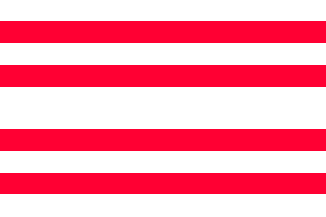
Last modified: 2006-12-09 by jarig bakker
Keywords: gorinchem |
Links: FOTW homepage |
search |
disclaimer and copyright |
write us |
mirrors
 Shipmate Flagchart : http://www.flagchart.net
Shipmate Flagchart : http://www.flagchart.net
Sierksma's Nederlands Vlaggenboek, 1962 [sie62]
has this about the flag:
"Description: Nine equally wide horizontal stripes of white and red;
the middle strip is twice as wide as the other stripes.
This flag was instituted by Mayor and Aldermen on 9 Aug 1939. The colors
are derived from the arms of the Van Arkels (which is on a small shield
on the municipal arms).
This flag is closely related to an image in Steenbergen (c. 1870) [stb65].
That has on the middle stripe the arms of the municipality.
A flag of that model has been reported by the Gorinchem mayor to the minister
of Internal Affairs in 1857."
Jaume Ollé has sent a lot of Steenbergen images to the Vexillum-mailing list,
amongst which
284.- No name -
That fits the description perfectly.
The Gorinchem municipal
website has a description of both flags, and adds to the 19th century
flag: below the wreath is written "GORINCHEM". Fortunately Steenbergen
forgot to include that...
Jarig Bakker, 15 Jun 2003
Gorinchem was my Friday evening's nightmare, exactly ten years ago,
when I came back from the Netherlands to France. A major crossroads between
two west-east and north-south highways is located near Gorinchem. I came
from east and had to turn south. As a revenge, I propose a new flag for
Gorinchem, grey (for the clouds) with a black cross for the roads. As a
result, I never visited the city of Gorincham, whose 'binnenstad'
seems to be nice.
The Guide Michelin has more fishy details on the Arkel family.
In 1417, Willem van Arkel attempted to reconquer the city from the
Hoeken, the partisans of Countess Jacoba van Beieren. Arkel belonged
to the Cod (Kabeljauwen; in French, cabillaud) party and
died during the fighting inside the city.
Jacoba was Willem IV's daughter. When he died in 1417, she inherited
the counties of Hainaut, Holland and Zeeland. In 1421, her second husband,
Jan IV van Brabant, spoliated her from the county of Holland which he gave
to her uncle Jan van Beieren, a partisan of the Kabeljauwen. Next
year, she married the Duke of Gloucester in England. Later, the Duke of
Burgundy Philips de Goede invaded her lands and she fled to Goes, in Zeeland.
Jacoba was forced to sign an agreement in Delft in 1428 (Zoen van Delft),
by which she promised to recognize Philips as her heir and never remarry.
In 1432, she broke her truce and lost in 1433 her title of Countess. She
died three years later in the castle of Teilingen, near Leiden.
Ivan Sache, 18 Jun 2003
![[Gorinchem 1938 flag]](../images/n/nl-zh_gc.gif) Shipmate Flagchart : http://www.flagchart.net
Shipmate Flagchart : http://www.flagchart.net
In use c. 1938
![[19th century flag]](../images/n/nl-zh_gk.gif) by Jaume Ollé, 15 Jun 2003
by Jaume Ollé, 15 Jun 2003
![[Gorinchem CoA]](../images/n/nl-zh)gc.gif) image from the Gorinchem
municipal website.
image from the Gorinchem
municipal website.
Granted 24 Jul 1816. Below the CoA is a scroll with the text: “Fortes creantur fortibus”: “Strong ones create strong ones"..